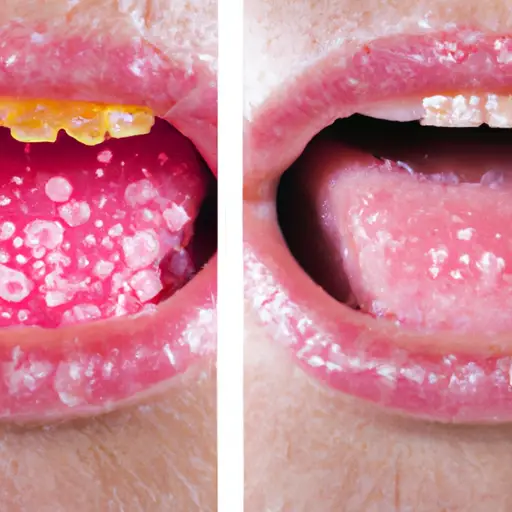So what is the difference between mouth ulcer and cancer
1. What are the main symptoms of a mouth ulcer?
Mouth ulcers are small, painful sores that appear in the mouth. The most common symptoms of a mouth ulcer include: an uncomfortable burning or tingling sensation caused by irritation to the tissue; a red ring around the sore and white or yellow center; swelling, tenderness, and pain when eating certain foods or brushing teeth; and bad breath. In some cases, people may experience difficulty speaking due to discomfort from their ulcer. If a person experiences any persistent signs or symptoms of a mouth ulcer they should seek medical advice as soon as possible for proper diagnosis and treatment.
2. How can you tell if a mouth ulcer is cancerous?
Mouth ulcers are generally harmless and not cancerous. However, if the ulcer does not heal within two weeks or grows larger over time, it may be a sign of something more serious such as oral cancer. Additional signs that could indicate an underlying cause can include lumps in the neck or mouth area, difficulty chewing, swallowing or speaking, loose teeth, white patches on soft tissues of the mouth and unexplained bleeding in the mouth. If any of these symptoms are present along with a persistent mouth ulcer you should consult your doctor for further evaluation. Your doctor may conduct a physical exam to check for signs of infection or other issues and may suggest biopsies to verify whether there is any malignant growth present.
3. Are there treatments available for both mouth ulcers and cancer?
Yes, there are treatments available for both mouth ulcers and cancer. For mouth ulcers, the most common treatment is to use a topical gel or ointment to help soothe the area and reduce pain. Additionally, medications such as ibuprofen or acetaminophen may be used to provide relief from discomfort. In more severe cases, prescription treatments may be necessary. For cancer treatment options vary depending on the type of cancer being treated but generally involve some combination of surgery, radiation therapy and/or chemotherapy. Surgery can remove tumors directly while radiation therapy uses high-energy rays to kill off cancer cells in affected areas of the body. Chemotherapy involves using drugs that target cancer cells specifically – although these drugs also damage healthy cells as well which can cause unpleasant side effects such as hair loss and nausea
4. Can certain lifestyle choices increase the risk of developing either condition?
Yes, certain lifestyle choices can significantly increase the risk of developing either type 1 or type 2 diabetes. Obesity is one of the leading causes for both types, so maintaining a healthy body weight is important. Poor diet and lack of physical activity also play a role in increasing risk, as does smoking and drinking excessive amounts of alcohol. Additionally, those who have family members with diabetes may be at higher risk than those who do not. It’s best to practice healthy habits like eating balanced meals and exercising regularly to help reduce your chance of developing either condition.
5. Is there any overlap in signs and symptoms between the two conditions?
Yes, there is some overlap between the signs and symptoms of depression and anxiety. Common overlapping symptoms can include difficulty sleeping, fatigue, feeling tense or irritable, difficulty concentrating, restlessness or jumpiness, and physical symptoms such as headaches or stomach aches. Both conditions can also cause a person to feel overwhelmed by their thoughts or emotions with no clear way out. In addition to these shared symptoms, depression may be marked by an overall depressed mood and low self-esteem while anxiety may present itself as intense fear in certain situations.
6. What tests might be used to diagnose each condition correctly?
In order to diagnose any medical condition correctly, it is important to use a variety of tests. Depending on the condition, some common tests that might be used include physical examinations, blood tests, imaging scans such as X-rays or MRIs, nerve conduction studies or other specialized assessments. For example, if someone has symptoms suggesting they may have diabetes then a fasting blood sugar test and an A1C test can be done to measure their glucose levels. Similarly for conditions like strokes and heart attacks an electrocardiogram (ECG) would be used to evaluate the electrical activity of their heart. Other diagnostic tools such as endoscopies or genetic testing may also be employed depending on the type of condition being tested for. It is important that the correct tests are chosen in order to confirm any diagnosis accurately and effectively so that appropriate treatment plans can begin as soon as possible
7. Does age or genetics have an impact on one’s susceptibility to develop either condition?
Age and genetics can both have an impact on one’s susceptibility to develop certain conditions. Genetics play a role in determining the risk of developing many types of diseases, including those that cause physical or mental health issues. Age is also a factor when it comes to some conditions; for example, older age groups are generally more at risk from certain illnesses than younger age groups. In addition, people who have family members with certain medical conditions may be more likely to develop them themselves due to their shared genetic makeup. Therefore, while it is difficult to definitively say whether age or genetics has a greater influence on someone’s susceptibility to develop an illness, understanding the potential risks associated with each can help individuals make informed decisions about how best to care for their health.
8. Is it possible for someone to have both a mouth ulcer and cancer at the same time?
Yes, it is possible for someone to have both a mouth ulcer and cancer at the same time. In fact, certain types of cancers can cause mouth ulcers as one of their symptoms. For example, some forms of throat cancer can cause persistent sores or lumps in the lower part of the throat which are often painful and may bleed easily. Additionally, some cases of lymphoma can result in swelling around the tongue or jaw leading to open sores that look like ulcers. However, it is important to note that most mouth ulcers are not symptomatic of any type of cancer but rather caused by an underlying condition such as vitamin deficiencies or stress.
9. How long does it take to recover from each respective ailment, on average?
On average, recovery times vary depending on the type and severity of the ailment. For minor illnesses such as colds or flu, full recovery can take anywhere from one to two weeks. Moderate cases of bronchitis may require up to six weeks for a full recovery. Severe illnesses including pneumonia and meningitis could require several weeks to several months before complete healing is achieved. In addition, chronic conditions like asthma may never fully resolve but can be managed with long-term medication or lifestyle changes.
10. Are there any preventative measures that can be taken against getting either a mouth ulcer or cancer in the future ?
Yes, there are some preventative measures that can be taken against getting mouth ulcers or cancer. For starters, it is important to practice good oral hygiene by brushing and flossing your teeth regularly. This helps reduce the risk of developing dental diseases like cavities and gum disease which can lead to mouth ulcers. Additionally, avoiding tobacco use in any form (smoking cigarettes, chewing tobacco) as well as limiting alcohol consumption and reducing stress levels can help decrease the odds of developing a mouth ulcer or cancer in the future. Eating an overall healthy diet with plenty of fruits, vegetables, whole grains and lean proteins also provides additional protection against these diseases. Finally, it’s important to routinely visit a dentist for check-ups so they can detect any changes in your oral health early on before they become more serious problems down the line.

